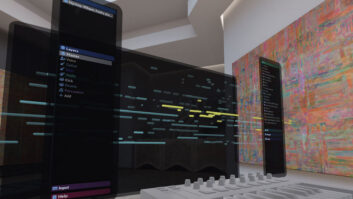
Haunted Studios, Ribbon Mics and Crafting Songs Slowly
There is a little bit of wooded landscape and bohemian artistry in Noah Georgeson’s music and mixes: As part of the Bay Area art community and growing up in near-by Nevada City, Calif. (where his 150-year-old “home” studio/art loft still stands by for personal projects), his music celebrate the area’s independent spirit using truly independent methods. Alongside other Bay Area–based artists, most notably The Pleased, Joanna Newsom and Devendra Banhart, Georgeson has translated his musical talent as a guitarist into successes as a producer and engineer, as well.
After earning a master’s degree in music at Mills College (Oakland, Calif.), the Bay Area–based Georgeson has been working and touring with various local artists. Georgeson took time out to talk to Mix after finishing the mixing/mastering sessions for Banhart’s upcoming release, out on XL Recordings (London).
So, how did you get started in the industry, and how did you evolve from being a musician to producing and engineering?
It’s something I’ve always done just for myself and to realize musical projects of my own. Part of what I studied at Mills was the studio aspect and the technology aspect in the context of being able to do stuff for yourself. I feel like there are a lot of places that are equipment-centric—there’s this intensive engineering aspect that’s probably necessary, but maybe at the expense of the piece of music. I feel like it’s easy to get distracted by the tools. My studies at Mills helped me, they encouraged [me to see that] they were a means to an end. I learned to be economical in my use and what I use to get a desired effect.
The first thing that I recorded that people took a lot of notice of was Joanna’s [Newsom] record, which was just last year, although I’ve done a record for a band I was once in, The Pleased, that came out November 2003 that got some nice attention as well.
Do prefer using digital or analog gear during the process?
[When I was working with Devendra Banhart on his upcoming release], we tracked everything to tape, and then we mixed in Pro Tools back to tape, so that it was a mixture of both things. Pro Tools is so easy, but we mix through a console.
Did you have any mentors over at Mills?
Their influence was more conceptual. I learned a lot, and there were a few people—Maggie Payne, Les Stuck, Alvin Curran—it was a really great environment for the creative process in general.
Speaking of Joanna’s album [Milk-Eyed Mender, 2004], during the recording sessions, was it evident that she’d get the kind of response that she has?
I’d known her and was around when she was writing all of those songs, so it was kind of natural recording them. It was hard for me to look at them at all objectively. I’m not surprised [at her success], because [hers] is such a unique [style], but I am surprised as many people as have been are open-minded at such a strange sounds as hers.
Where do you record when you’re in the Bay Area? Do you have a home studio?
I have a little studio up in Nevada City: It’s basically an artist’s studio—an old convent and orphanage that’s been around for 150 years—it’s this creaky old wooden building with a big hall and slightly smaller room. I recorded a B-side for one of [Joanna Newsom’s] singles there. Devendra we did out on the East Coast at Bearsville (Bearsville, NY), right next to Woodstock [where] Todd Rungren ran the studio for a long time. It was a really incredible studio.
I go where I’m needed; I’ll record little projects [in the Nevada City studio]; often, it seems like a better idea to just go into a studio [locally]. There is quite a distinct sound to the place; it’s not intended to be a recording studio. It’s kind of nice for that very reason. If any place is haunted, it’s got to be that place!
What were your goals in engineering Newsom’s album? Did you come up against any obstacles during the recording sessions?
The obstacles were kind of technical at first. We wanted to use tapes, but then the tape machine that we were using had a really bad noise problem and I used a lot of microphones on the harp because it tends to bleed sound in all directions. There’s no real place where you can stick a mic. We took a lot of time setting up the microphones to try and treat the ranges of the instruments as separate instruments. When it’s just one instrument and a voice, it felt important to me to really separate the ranges and treat them as different instruments, like an orchestra or a band or something.
Where did you work with Newsom?
We did it at our home at the time, in San Francisco. We had access to some nice microphones, and we just did it at home and mixed it in our room. What was great about it, really, was that there was no pressure and we could sit and hear one song and we could just walk away. That’s what I prefer, especially from the mixing end of things: to be able to listen to it a lot. I’m a perfectionist, but not in any technical sense. Once I get an idea or an aesthetic in my head, it’s hard to dissuade me. Sometimes you can go too far and listen to how things were five hours ago was better than things are now.
What’s going on with The Pleased these days?
We’ve all been very busy with other things. I did two national tours with them last year; in the fall, I went off with Devendra through the U.S. and then through Australia, got back and then we went back east. We just finished the record, mastered it and now I’m working on a radio mix.
Do you have any tips or techniques to share with other engineers?
To be able to work wth people you care about and whose music you care about can make all of the difference. As far as equipment goes, one thing that Devendra’s record really showed me was ribbon mics: They make all the difference. On drums, not using any condenser mics on drums, just using ribbons—like Coles or RCA 77s–on string, violin and cellos is [beautiful]. Of course, it’s been done that way for a long time: It just gives a really intimate, timeless sound to things.
To nominate your favorite engineer for a profile in “Generation Mix,” e-mail [email protected].







